Poland 2025 "Dinosaurs"
| <prev | back to index | next> |
| Issue Date | 30.08.2025 |
| ID | Michel: ; Scott: ; Category: pR |
| Design | Andrzej Gosik Consultant Dr. Gerard Gierliński from the Polish Geological Institute |
| Stamps in set | 3 |
| Value |
Pzl 4,90 - Camptosaurus Pzl 4,90 - Europasaurus Pzl 4,90 - Compsognathus |
| Emission/Type | commemorative |
| Places of issue | Warsaw |
| Size (width x height) | 76.5 mm x 31.25 mm |
| Layout | Mini-Sheet of 2 sets (6 stamps in total) |
| Products | FDC x 3, Mini-Sheet x1 |
| Paper | white medium smooth fluorescent |
| Perforation | 12 x 11.5 |
| Print Technique | Offset |
| Printed by | Polska Wytwrnia Papierw Wartosciowych (PWPW) |
| Quantity | 90.000 sets |
| Issuing Authority | Polish Post |
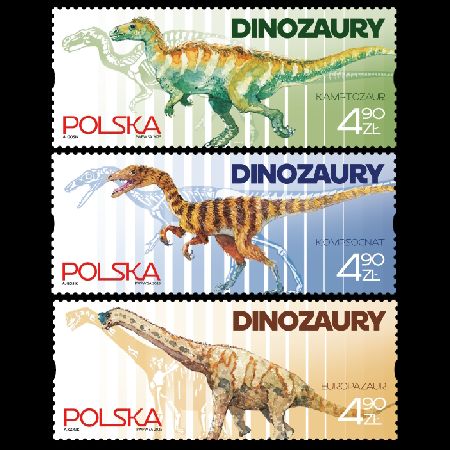
On September 30th, 2025, three years later than originally planned, the Polish Postal Authority issued the second set of 3 "Dinosaurs" stamps. The first set in this series was released in 2020. Distinct from the previous release, the stamps depict skeletons and reconstructions of three European Late Jurassic dinosaurs Camptosaurus, Europasaurus and Compsognathus, chosen for their scientific interest and educational value. These genera are represented for their association with Europe’s Late Jurassic faunas and are not claimed to be Polish discoveries.
These stamps are based on illustrations made by Polish artist Andrzej Gosik who painted his sketches with his favorite watercolor technique, in cooperation with Dr. Gerard Gierliński from the Polish Geological Institute – Jurapark.
The First Day Cover (FDC) cachet features the skeletons of all three dinosaurs, while the First Day of Issue postmark depicts a Camptosaurus skull, emphasizing its distinctive anatomical features.
Camptosaurus is a genus of herbivorous, beaked ornithischian dinosaurs known from western North America and western Europe, that lived during the Late Jurassic and the Early Cretaceous periods (161.2 - 99.6 million years ago).
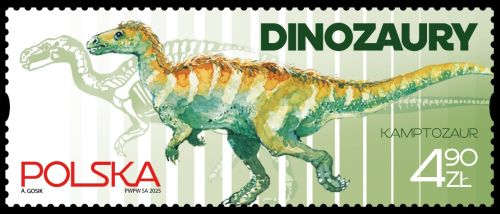 |
| Camptosaurus on stamps of Poland 2025, MiNr.: , Scott: |
 |
| Camptosaurus on one of the "The World of Dinosaurs" stamps of USA 1997, MiNr.: 2815, Scott: 3136b. |
The genus was first described in 1885 by the renowned American paleontologist Othniel Charles Marsh, based on fossils discovered in 1879 by fossil collector William Harlow Reed in Albany County, Wyoming.
In the late 19th and early 20th centuries, fragmentary ornithopod remains found in England, France, and Germany were often tentatively referred to Camptosaurus due to superficial similarities with the American specimens. These identifications were largely based on isolated limb bones and vertebrae, reflecting the limited comparative knowledge available at the time.
One of the earliest and most complete European finds associated with Camptosaurus came from the Chawley Brick Pits at Cumnor Hurst in Oxfordshire, England. The fossils were discovered by Sir Joseph Prestwich (1812–1896), a geologist and professor at Oxford in 1879 and were described by John Whitaker Hulke (1830-1895), a British surgeon, geologist, and fossil collector — who assigned them to Iguanodon, naming the species Iguanodon prestwichii in Prestwich’s honor.
In 1889, British paleontologist Richard Lydekker re-examined the material and reassigned it to Camptosaurus, renaming the species Camptosaurus prestwichii.
In 2022, a team of Spanish paleontologists described fragmentary remains attributed to Camptosaurus sp. from Alpuente in the Province of Valencia, Spain. The presence of members of the genus Camptosaurus in both Spain and England, alongside the North American record, is consistent with the hypothesis that a land connection existed between Europe and North America during the early Late Jurassic, allowing faunal exchange between the two continents before the Atlantic Ocean opened up.
Europasaurus, is a genus representing one of the smallest known sauropod dinosaurs, distinguished by its arched skull, proportionally long neck, and elevated shoulders. Fossils of this dinosaur are known from a single quarry in northern Germany, in rock layers dating to the Late Jurassic Epoch, around 150 million years ago.
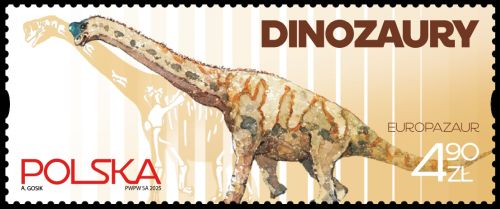 |
| Europasaurus on stamps of Poland 2025, MiNr.: , Scott: |
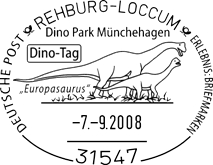 |
| Europasaurus on postmark of Germany 2008 |
The fossils, discovered between 1998 and 2000, in Langenberg Quarry near Oker, Lower Saxony, were prepared and housed at the Dinosaur Park Münchehagen (DFMMh), a private open-air museum near Hanover. Unfortunately, part of the Europasaurus material was damaged or destroyed in an arson attack during the night of October 4–5, 2003. The fire consumed the laboratory and exhibition hall, resulting in the loss of 106 bones, approximately 15% of the prepared specimens at that time.
In 2006, the new sauropod was formally named Europasaurus holgeri. The genus name means “European lizard,” while the species name honors Holger Lüdtke, the discoverer of the first fossils. Fossils from the same site suggest that Europasaurus shared its habitat with small theropods and crocodile-like reptiles, forming a distinct island ecosystem.
Microscopic analysis of bone tissue from several individuals revealed that the specimens represent various growth stages and confirmed that the largest individual was fully mature. Known Europasaurus individuals range from about 1.7 meters in length for juveniles to 6.2 meters for the largest adults, which likely weighed between 500 and 2,000 kilograms in life.
Studies suggest that Europasaurus reached small size through slowed growth rates, rather than early stopping of growth — an important evolutionary adaptation in response to limited island resources.
Sauropods were typically the largest land animals to have ever lived, so the small size of Europasaurus is considered a classic example of island dwarfism.
During the Jurassic, much of what is now Europe was submerged beneath shallow seas and divided into numerous islands. These small landmasses could not support large herbivores, but smaller-bodied individuals with lower food requirements would have had a survival advantage. A similar case of dwarfism in dinosaurs is seen in the Late Cretaceous fauna of Hațeg Island in modern-day Romania.
Europasaurus stands as one of the clearest examples of how evolution shapes life in isolated environments.Compsognathus is a genus of small, bipedal, carnivorous theropod dinosaurs from the Late Jurassic Epoch (about 161–146 million years ago). The name Compsognathus comes from Greek and means ‘elegant’ or ‘refined jaw,’ referring to its slender and lightly built skull. Roughly the size of a chicken, it was a lightly built and agile runner with a long neck and tail, strong hind limbs, and very small forelimbs. Fossils of Compsognathus are known exclusively from Europe, specifically Germany and France.
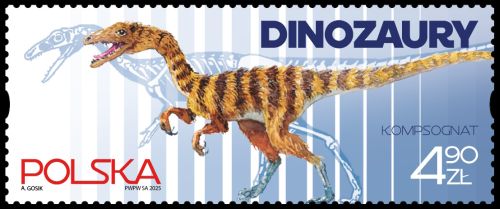 |
| Compsognathus on stamps of Poland 2025, MiNr.: , Scott: |
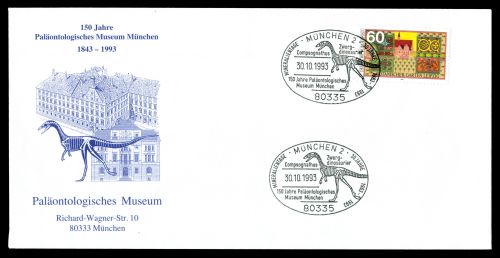 |
| Compsognathus on the cachet and postmark of commemorative cover of Munich Paleontological Museum from 1993. |
The genus was first described in 1859 by the German paleontologist Johann Andreas Wagner (1797–1861), based on a nearly complete skeleton that even preserved impressions of stomach contents, later identified as small lizards, offering rare insight into its diet. Wagner did not recognize Compsognathus as a dinosaur and instead considered it “one of the most curious forms among the lizards”. Despite this misclassification, the find made Compsognathus one of the best-known fossil reptiles of the 19th century.
In 1866, the specimen, part of the fossil collection of Joseph Oberndorfer, was acquired by the Bavarian State Collection for Paleontology in Munich.
In 1868 and 1870, the British naturalist Thomas Henry Huxley, a leading advocate of Darwin’s theory of evolution, compared Compsognathus with Archaeopteryx, then regarded as the earliest known bird. Building on earlier ideas by Carl Gegenbaur and Edward Drinker Cope, Huxley noted the anatomical similarity between the two and referred to Compsognathus as a “bird-like reptile”. He concluded that birds must have evolved from dinosaurian ancestors, helping establish Compsognathus as one of the most scientifically significant dinosaurs of its time. The specimen was subsequently studied by many notable paleontologists, including Othniel Charles Marsh, who visited Munich in 1881.
A second, larger specimen was discovered near Canjuers, close to Nice in southern France, in the late 19th century, but it was not fully described until 1972 by Alain Bidar and colleagues. Initially thought to represent a separate species due to its greater size and what was interpreted as a flipper-like hand, it is now often considered to be an adult individual, whereas the German specimen may have been a juvenile. The French fossil was acquired by the National Museum of Natural History in Paris in 1983.
Together, the European specimens of Compsognathus were among the first dinosaurs recognized as agile, bird-like hunters, rather than slow, lizard-like reptiles — a crucial milestone in the understanding of dinosaur evolution.
For over 100 years, Compsognathus was celebrated as the smallest known dinosaur, a title it held until much smaller feathered theropods were discovered in Asia during the late 20th century. Although no direct fossil evidence of feathers has been found in Compsognathus, its close relatives from China suggest that it may have been partially feathered.
Products and associated philatelic items
| Mini-Sheet | FDCs | First-Day-of-Issue Postmark |
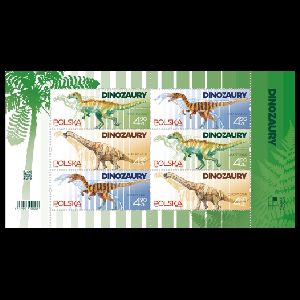 |
 |
 |
| Examples of circulated covers | ||
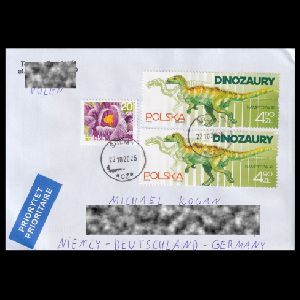 |
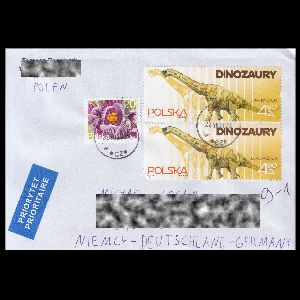 |
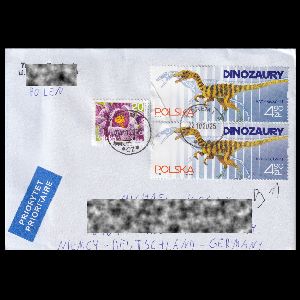 |

|
References
- Technical details and short description: Poczta Polska [1], [2]; notafilia.pl;
- Camptosaurus: Wikipedia, Encyclopaedia Britannica,
- Europasaurus: Wikipedia, Encyclopaedia Britannica,
- Compsognathus: Wikipedia, Encyclopaedia Britannica,
Acknowledgements
Many thanks to Dr. Peter Voice from Department of Geological and Environmental Sciences, Western Michigan University, for reviewing the draft page and his very valuable comments.| <prev | back to index | next> |